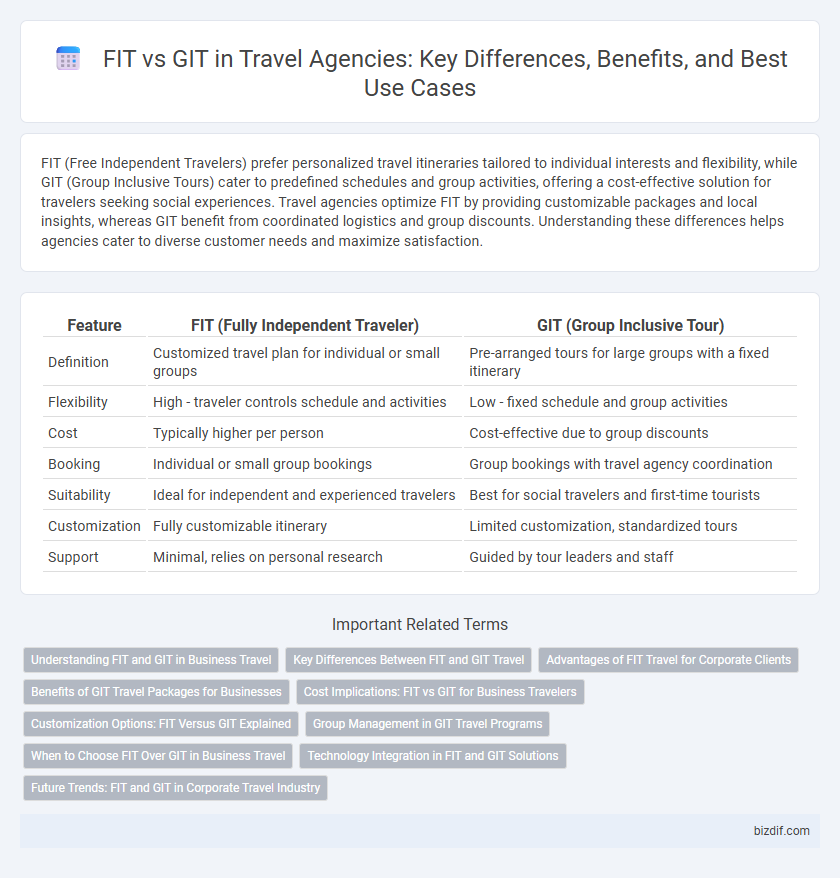FIT (Free Independent Travelers) prefer personalized travel itineraries tailored to individual interests and flexibility, while GIT (Group Inclusive Tours) cater to predefined schedules and group activities, offering a cost-effective solution for travelers seeking social experiences. Travel agencies optimize FIT by providing customizable packages and local insights, whereas GIT benefit from coordinated logistics and group discounts. Understanding these differences helps agencies cater to diverse customer needs and maximize satisfaction.
Table of Comparison
| Feature | FIT (Fully Independent Traveler) | GIT (Group Inclusive Tour) |
|---|---|---|
| Definition | Customized travel plan for individual or small groups | Pre-arranged tours for large groups with a fixed itinerary |
| Flexibility | High - traveler controls schedule and activities | Low - fixed schedule and group activities |
| Cost | Typically higher per person | Cost-effective due to group discounts |
| Booking | Individual or small group bookings | Group bookings with travel agency coordination |
| Suitability | Ideal for independent and experienced travelers | Best for social travelers and first-time tourists |
| Customization | Fully customizable itinerary | Limited customization, standardized tours |
| Support | Minimal, relies on personal research | Guided by tour leaders and staff |
Understanding FIT and GIT in Business Travel
FIT (Free Independent Traveler) refers to individual business travelers who plan and customize their trips independently, prioritizing flexibility and personalized itineraries. GIT (Group Inclusive Tour) involves organized travel for groups, often corporate teams, offering economies of scale, coordinated schedules, and streamlined booking processes. Understanding the distinctions between FIT and GIT enables travel agencies to tailor services, optimize cost efficiency, and enhance traveler satisfaction in business travel management.
Key Differences Between FIT and GIT Travel
FIT (Free Independent Traveler) refers to individuals or small groups organizing personalized travel itineraries, emphasizing flexibility and tailor-made experiences. GIT (Group Inclusive Tour) involves pre-arranged group travel packages led by a guide, focusing on cost-efficiency and social interaction among participants. Key differences between FIT and GIT include customization level, group size, pricing structure, and the degree of autonomy during the trip.
Advantages of FIT Travel for Corporate Clients
FIT travel offers corporate clients personalized itineraries tailored to specific business needs, ensuring flexibility in scheduling and destination choices. Companies benefit from enhanced control over travel arrangements, which can optimize productivity and reduce unnecessary expenses. This customized approach supports better work-life balance for employees by providing more comfortable and convenient travel experiences.
Benefits of GIT Travel Packages for Businesses
GIT travel packages offer businesses cost savings through group discounts and streamlined booking processes that minimize administrative workload. These packages provide tailored itineraries that enhance team-building and corporate networking opportunities, improving overall trip efficiency and employee satisfaction. Companies benefit from dedicated support and flexibility in arrangements, ensuring seamless group travel experiences aligned with corporate objectives.
Cost Implications: FIT vs GIT for Business Travelers
FIT (Fully Independent Traveler) options generally incur higher costs due to personalized itineraries and a la carte services catering to individual preferences. GIT (Group Inclusive Tour) offers cost advantages through bulk bookings, shared accommodations, and negotiated group rates, significantly lowering expenses for business travelers attending conferences or corporate events. Businesses aiming to optimize travel budgets often prefer GIT arrangements to leverage economies of scale and secure better pricing on transport and lodging.
Customization Options: FIT Versus GIT Explained
FIT travelers benefit from extensive customization options, tailoring itineraries to personal preferences, interests, and schedules, resulting in a highly personalized travel experience. GIT packages typically offer standardized group itineraries with limited customization, designed to accommodate the collective preferences of multiple travelers. Travel agencies often provide flexible add-ons or optional excursions within GIT to enhance personalization while maintaining overall group structure.
Group Management in GIT Travel Programs
GIT (Group Inclusive Tour) travel programs streamline group management by offering tailored itineraries, negotiated group rates, and dedicated coordinators to handle logistics efficiently. These programs enable travel agencies to manage bookings, transportation, and accommodations collectively, reducing complexity compared to FIT (Free Independent Traveler) arrangements, which are individually customized. Group management in GIT enhances cost-effectiveness and ensures seamless coordination for large parties, optimizing resource allocation and service delivery.
When to Choose FIT Over GIT in Business Travel
Choosing FIT (Fully Independent Traveler) over GIT (Group Inclusive Tour) in business travel is ideal when personalized schedules and tailored itineraries are paramount for optimizing time and productivity. FIT options provide flexibility for meetings, exclusive accommodations, and bespoke transportation arrangements that align with individual business needs. This approach is particularly beneficial for solo travelers or small teams requiring autonomy and efficient coordination without the constraints of group travel timelines.
Technology Integration in FIT and GIT Solutions
Technology integration in FIT (Fully Independent Travel) solutions prioritizes personalized booking platforms and AI-driven recommendations, enabling travelers to customize their itineraries with ease and flexibility. GIT (Group Inclusive Tour) solutions leverage centralized management systems and automated group coordination tools, streamlining operations and improving communication for large group travel. Both FIT and GIT technologies enhance customer experience but differ in scalability and customization focus.
Future Trends: FIT and GIT in Corporate Travel Industry
Future trends in the corporate travel industry indicate a growing preference for FIT (Fully Independent Travel) due to its personalized itineraries and flexibility, while GIT (Group Inclusive Travel) remains popular for cost-efficiency and team-building purposes. Advanced AI-driven booking platforms and real-time data analytics are enhancing the management of both FIT and GIT, optimizing travel plans and corporate budgets. Sustainability and hybrid travel solutions are expected to shape the future, with companies increasingly prioritizing eco-friendly options in both individual and group travel arrangements.
FIT vs GIT Infographic

 bizdif.com
bizdif.com